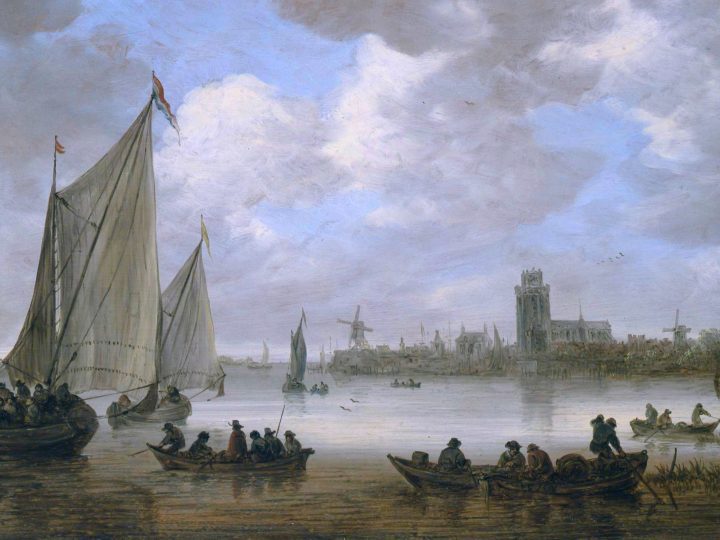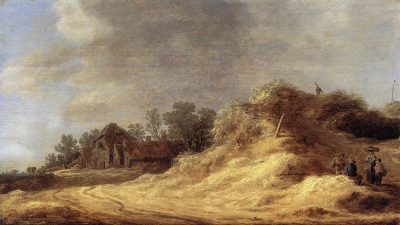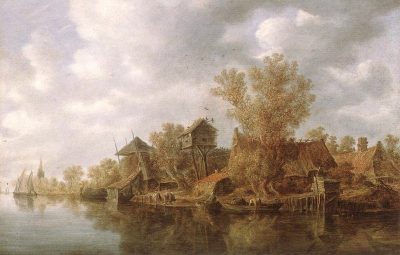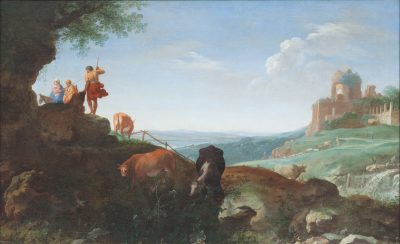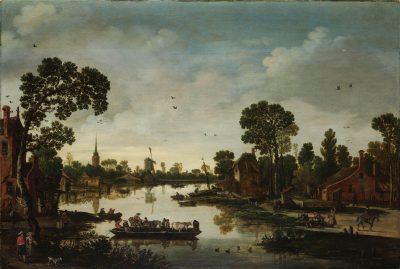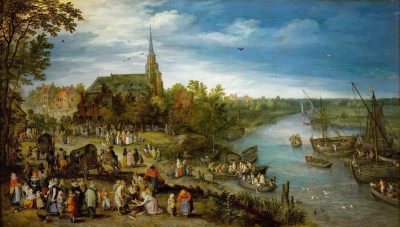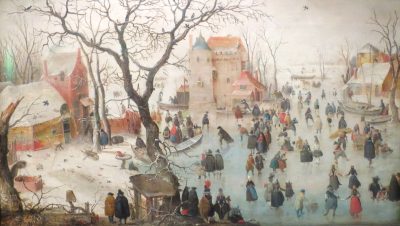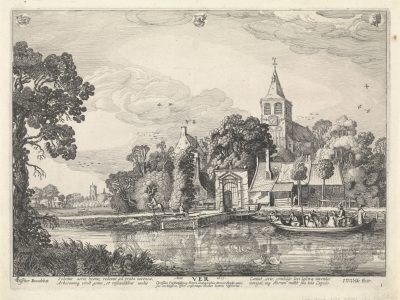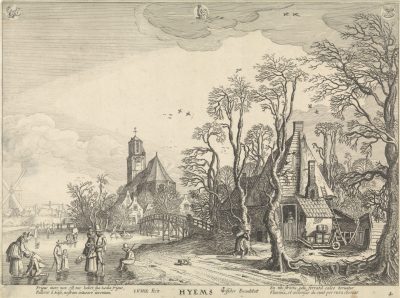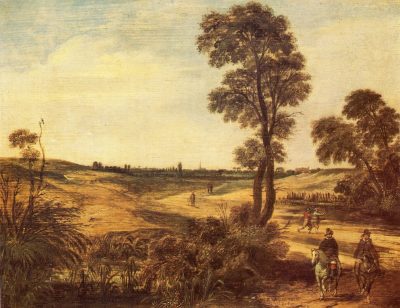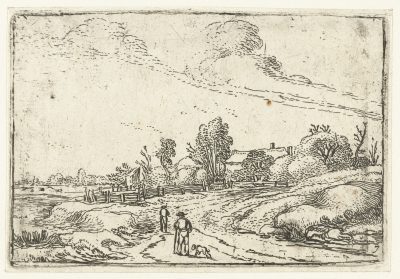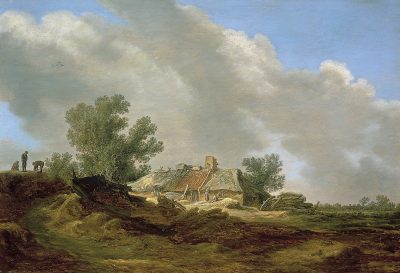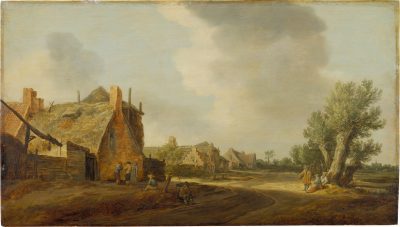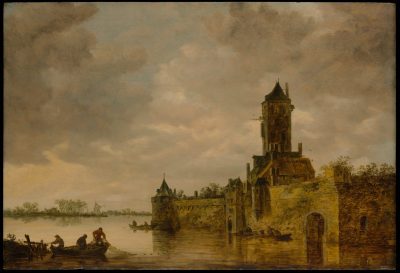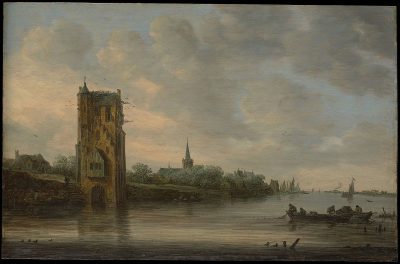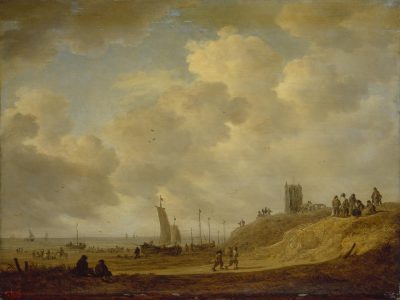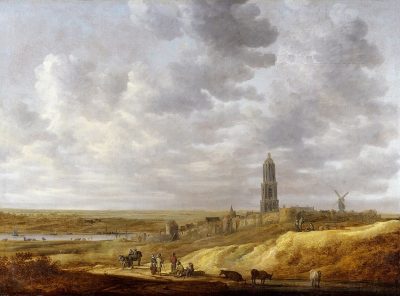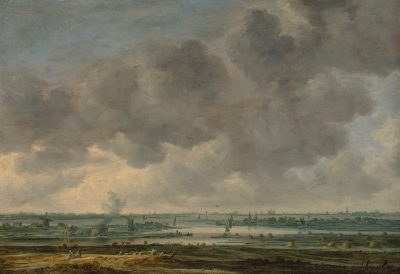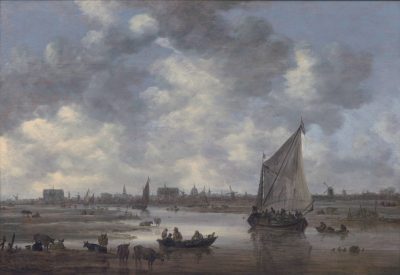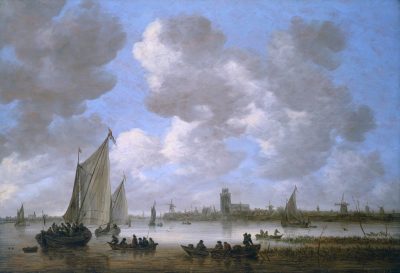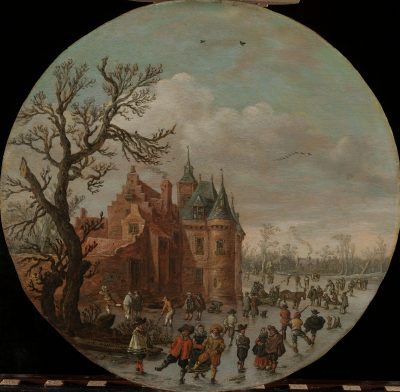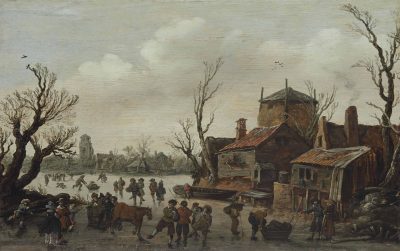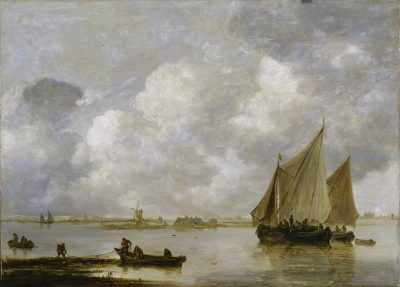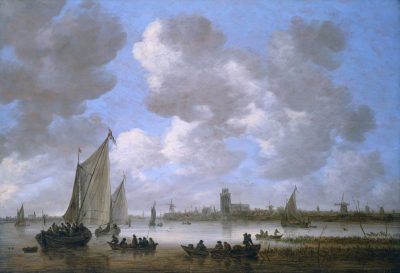This article is a translation from the original Dutch, which first appeared in the catalogue for the exhibition Jan van Goyen (Stedelijk Museum De Lakenhal, Leiden, 1996). The essay examines the “strategies” regarding style, subject matter, technique, and price level that Jan van Goyen appears to have used to position himself in the art market. In particular, it discusses the radical change in style and the continuous innovations that Van Goyen introduced into his landscapes as he became a market leader. The Postscript offers insight into the origin and aim of the essay and refers to relevant information that emerged after the initial publication date.
Author’s Note, 2021
At some places in the present translation, I have referred in footnotes between curly brackets {braces} to other more recent publications on topics discussed in the article. In the article itself, I have added a few lines prompted by more recent information, also identified by curly brackets.
A Renowned Landscape Painter
In the first half of the seventeenth century, Jan van Goyen’s contemporary Constantijn Huygens was the only author to record his opinion on Dutch landscape painting. The words that he committed to paper, in the autobiography of his youth, make clear that Huygens considered the art of landscape painting a miraculous phenomenon. His immense admiration for Rubens and his excessive praise for the young Rembrandt did not interfere with a profound appreciation for contemporary landscape painters: “One could even say that nothing is lacking in the work of those clever men except for the warmth of the sun or the movement caused by a gentle breeze.”1
According to Huygens, “the harvest of landscape painters in our Netherlands is so vast and so renowned that one would need to write a whole booklet to mention them one by one.” Thus, if we are to believe Huygens, landscape painting had achieved broad fame by the late 1620s. This was indeed a decade in which the production of landscape paintings increased hugely, although the apogee—at least where quantity is concerned—was still to come. Of the five landscape painters whom Huygens mentioned by name, he praised in particular the Antwerp painter Jan Wildens, a friend of Rubens, as well as Esias van de Velde, based in The Hague. However, he began by stating: “as for the rest, their own reputation should plead for them, and that of Van Poelenburch, Van Wtenbrouck, Van Goyen, and others is truly quite extraordinary.”2
The most remarkable aspect of this statement is Huygens’s mention of such opposites as Cornelis van Poelenburch (fig. 1) and Jan van Goyen (fig. 2) in the same breath. We might expect something different from this courtier, poet, and homo universalis, who could boast a consummate humanistic education. With these words of praise about landscape painters, he does not place any higher value on the painters of idyllic, Italianate landscapes with Roman ruins and small biblical, mythological, or pastoral scenes than the artists who painted the Dutch landscape and took inspiration from the surroundings of Leiden, Haarlem, and The Hague: landscapes with farmhouses, villages, waterways, pastures and dunes, where peasants and travelers proceed on their way (in addition to Van Goyen, Esaias van de Velde also produced work in this vein; see fig. 3).
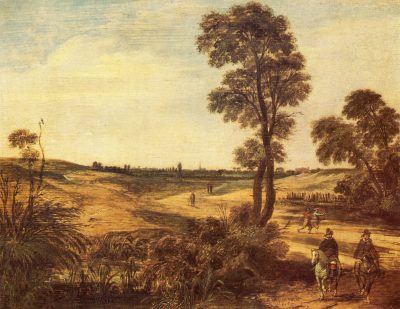
Not only did Huygens place painters who made different types of landscape on a par with one another, these artists also worked in different painting techniques, producing pictures that differed greatly in price. Cornelis van Poelenburch’s landscapes were costly paintings executed with exquisitely detailed and refined technique. Esaias van de Velde, on the other hand—and his pupil Van Goyen would emulate him in the extreme—developed a rapid painting technique that enabled him to produce relatively cheap pictures at a fast pace. Apparently, Huygens appreciated both landscape types.3
A comparable opinion, more strongly put, is found in an earlier paragraph of Huygens’s text; here he says that he can hardly name Hendrik Vroom in the same breath as Jan Porcellis.4 In this case, we see how, in Huygens’s opinion, an artist who mainly painted costly, finely rendered works—paintings with many details, in which imposing warships or East Indian merchantmen were depicted with great accuracy—had been surpassed by an artist who made inexpensive, rapidly painted, unpretentious images of anonymous fishing boats and other inland vessels sailing the Dutch waters (fig. 4).5
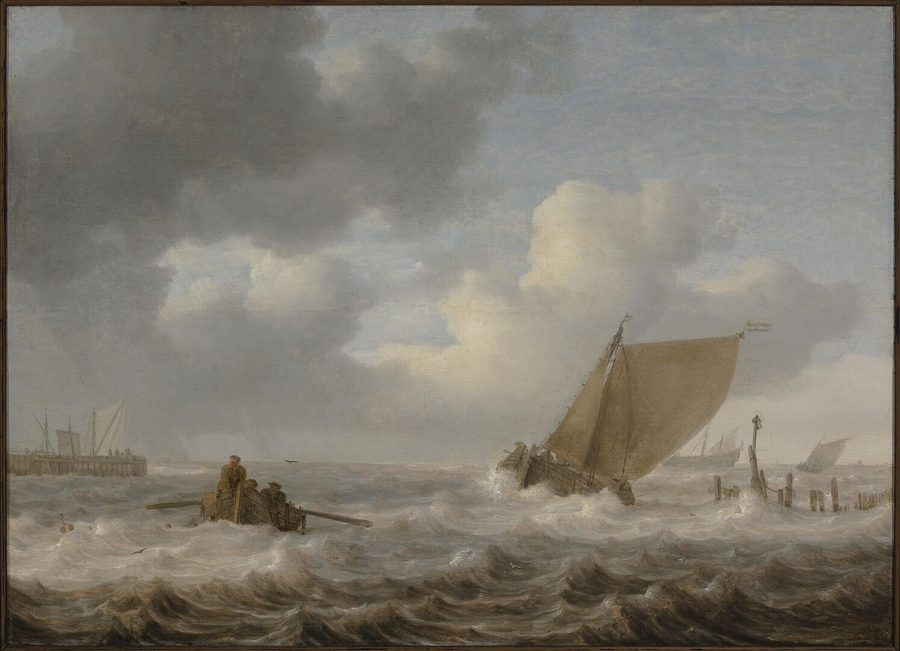
In art-historical literature, it has often been maintained that paintings of Dutch landscapes were valued less than those of foreign scenes and that these cheaper pictures were meant for a less sophisticated public. Many twentieth-century authors asserted that Van Goyen was not much appreciated by his contemporaries and was even so badly paid for his paintings that he could make a living only by working at another occupation.6 If it were indeed true, however, that people “wanted to pay much less for a native subject one could see outside every day,” as Henri van de Waal stated,7 the question remains why these images were painted in such incredible numbers—not only by Van Goyen and such colleagues as Salomon van Ruysdael, but also by Van Goyen’s numerous followers, all of whom apparently considered them profitable. This was not a matter of an inner artistic need, contrary to the opinion of many past art historians. Scholars in the nineteenth and twentieth centuries were probably misled by the relatively low prices of Van Goyen’s works. They were eager to assume that Van Goyen was undervalued by his contemporaries and that the depiction of the commonplace and the familiar did not receive the recognition it deserved. The words of someone like Constantijn Huygens, who had called Van Goyen a renowned master as early as 1631, point us in another direction.
A decade later, a report on Van Goyen appeared in the Description of the City of Leiden (Beschrijvinge der stad Leyden) (1641) by the Leiden burgomaster Jan Orlers. This book praises Leiden’s greatness in the past and the present by exhaustively describing its history, government, and institutions. Further, Leiden’s famous “sons” are honored with short biographies. Orlers chose only two groups of people to represent these illustrious citizens—scholars, and painters—and he paid a great deal of attention to the latter. Apparently, he saw them as contributing greatly to the city’s fame. For the painters of the sixteenth century, Orlers made use of biographies written by Karel van Mander, with whom he had been friendly in his younger years. For the living painters he added to the second edition of 1641, he had to draw from his own assessment and knowledge. To that end, he addresses a limited selection of seven artists: David Bailly, Joris van Schoten, Jan van Goyen, Pieter de Neyn, Rembrandt van Rijn, Jan Lievens, and Gerrit Dou. The inclusion of a biography in such a prestigious book would have given these painters exceptionally high status in the city’s society; it must have contributed enormously to their self-esteem and self-confidence.8
Orlers’s writing about these artists shows no hierarchic differentiation between painters of histories, landscapes, portraits, or contemporary life. They all belong to the category of “famous and excellent Painters, whose worthiness and deserved glory can easily be proven by their immensely beautiful and priceless Paintings, which can be found inside as well as outside the city: with these they deserve and are worthy of being recorded and registered in all books of Laudation and History.”9
Orlers dedicates more than one page to Jan van Goyen—equal to Gerrit Dou, and many more lines than he devotes to Rembrandt. Remarkably, he pays detailed attention to Van Goyen’s apprenticeship with six(!) different masters, probably to give an example of the intensive schooling necessary to become a renowned master in painting. He characterizes Van Goyen as one of the “most artful landscape painters . . . who in our time and age are famous and well known.” He also explicitly praises Van Goyen’s capability in painting figures (“and the pleasantness of the figures therein”).10 Lastly, he adds that “of this the numerous paintings that are highly valued by all liefhebbers can bear witness.” Thus, Orlers also emphasizes that liefhebbers (lovers of art, connoisseurs) show great esteem for Van Goyen’s works. How can this be reconciled with the low prices of Van Goyen’s paintings?
Position in the Art Market
As noted above, Van Goyen used a rapid technique that was developed concurrently by Esaias van de Velde and Jan Porcellis around 1615—during the period of Van Goyen’s apprenticeship and early independence. This manner of painting, in which only a few colors were applied with loose brushstrokes in one layer onto a thin ground, made a large production possible and lowered the cost of materials as well.11 Half a century later (1678), Van Hoogstraten refers to this phenomenon by saying that, although in the beginning of the century the walls in Holland were not as crammed with paintings as they are in his time, the practice daily became more and more fashionable, “which strongly impelled some painters to take to rapid painting, yes even to produce one piece a day, whether small or large.” In this way, they “sought both profit and fame.”12 Van Hoogstraten here alludes to such painters as Porcellis and Van Goyen, judging by the anecdote he tells immediately afterward of a painting contest between Van Goyen, Porcellis, and Knibbergen. We cannot establish with certainty if it was usual for these artists to make one painting, “whether small or large,” in one day, but we do know that in 1615 Porcellis signed a contract with an art dealer stating that he would deliver two paintings every week.13
John Michael Montias was the first to demonstrate convincingly that, in addition to radical specialization, this “process innovation” was an efficient way to economize on the cost of labor in a period wherein—as Van Hoogstraten makes clear—the demand for paintings as well as the competition among artists was growing explosively.14 From the 1620s on, the young painter thus had the choice between this rapid, inexpensive method of production that required a “loose” manner of painting, or the more traditional “neat” (and therefore more expensive) painting technique.15 Van Goyen chose—only after some time, as we will see—the first method and would develop it to the extreme, while other painters of his generation did the same in different genres. These include such artists as Dirck Hals in paintings of contemporary life or Pieter Claesz. in still lifes. On the other hand, such landscape painters as Cornelis van Poelenburch (figs. 1, 11) and Alexander Keirincx (fig. 5) chose the second method, as did Balthasar van der Ast in still lifes (to name a few); Van Goyen’s younger fellow townsman, Gerrit Dou, explored the “neat” manner to its fullest potential.
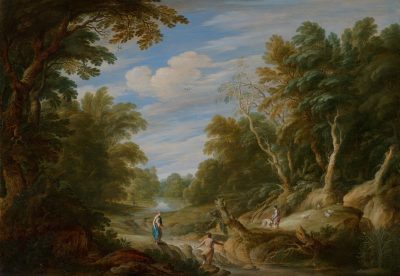
Once artists no longer worked on commission and their pictures were sold via their own shops or through art dealers, auctions, or lotteries, the latter method would have brought more risks. Using this time-consuming working method would have made it more aggravating when a painting was not sold for a long time: one needed to have some certainty about clients who could be trusted to buy the painting one had spent so much time on. In the case of Gerrit Dou, we know that even in his early period he could rely on several collectors who were more than eager to buy his works, and in one case paid him a yearly stipend for the right of first refusal.16 A painter like this mainly worked for a relatively small group of liefhebbers, who every once in a while visited the artist’s workshop. The works of such painters—this is also true of Cornelis van Poelenburch—therefore often ended up with a few rich collectors who, as Maecenas, frequently bought their paintings.17
There was less risk in using a rapid production method, and the number of painters who fabricated cheaper works must therefore have been large. For most of them, making paintings in the manner of better-known masters would have been the safest way to guarantee a sufficient income. Those who had above-average capacities and ambition, however, sought to gain a place in the art market by becoming known for a recognizable type of painting of good quality.18 Some of them succeeded well by combining technical virtuosity and exceptional inventiveness in developing new types of painting that were received favorably. Jan van Goyen definitely belonged among those few artists and, given the large number of followers throughout his career, could be called a trendsetter and market leader.19 In a relatively short period of time, he made a name for himself and earned good money.
Van Goyen was intensely involved with speculating in real estate. But that alone is not evidence that he needed other activities to support himself, as has generally been suggested.20 Rather, it meant that he soon earned enough money to invest in order to increase his capital; he was an eager speculator, like many of his contemporaries. From 1625 on, he bought houses and pleasure gardens for hefty sums, sometimes with cash deposits, and sold them as soon as possible. After moving to The Hague, he bought plots of land for the construction of houses in a time when the city was rapidly expanding.21 The poor outcome of this enterprise suggests that his speculative spirit was stronger than his insight or luck in this field.22 Nonetheless, although he had large debts at his death, he still owned six houses in The Hague, which sold for 15,670 guilders in total.23
Apart from his speculation in property and his art dealing, Van Goyen’s large production of paintings gave him a sufficient and reasonably secure income during most of his life. It seems that when times were good—as in the years 1636 to 1639, when he was busy building houses—the number of his paintings dropped drastically. When his debts increased because of his less lucrative dealings as a speculator and contractor, he augmented his painting production dramatically (1641–1647).24 This recalls a poem by Jacob Cats in which a painter, a merchant, and a poet compete for the hand of a young beauty. In recommending himself and his craft, the painter asserts that he can do business like the merchant, but his art involves him in no risks. When the merchant loses his merchandise—by a shipwreck or some other disaster—he has nothing left, but the painter declares that if something like that happened to him, he would still have his art:
The Art, that noble thing, will not abandon me,
Even had I to roam the streets without proper clothes;
Even were I fleeing from war, running from fire,
I would still own my very best asset.
Contrasting the advantages of painting against the arguments of the poet, this same painter states that he can earn good money with his art: “And that is very useful if one has a home and a family.”25
A painter’s earnings could vary immensely, however. In a 1642 request to the City Council, painters in Haarlem distinguished between “ordinary painters” (gemeene schilders) and “extraordinary masters” (extraordinare meesters); the latter were, of course, the artists who signed the petition: Frans Pietersz. de Grebber, Frans Hals, Pieter de Molijn, and Salomon van Ruysdael.26 For the “ordinary” painters, the makers of “paintings of low quality” (slechte schilderijen), it was not easy to keep afloat financially. Often they worked for art dealers who specialized in the cheapest market segment, mostly selling their paintings anonymously.27 These artists were probably the suppliers of the numerous anonymous works we find in seventeenth-century inventories, paintings whose makers were not identified when an inventory was drawn up and whose price estimates were very low (usually less than five guilders).28 The other end of the spectrum included the “extraordinary masters,” those painters who had made a name for themselves and whose works were much appreciated, ranging from history and genre painters to landscape painters such as Pieter de Molijn and Salomon van Ruysdael. They mostly sold their works from their own workshops, and the authors of inventories frequently identified their paintings by name.29 Jan van Goyen belonged at the top of this category.
A Wide Popularity
Inventories that include paintings collected during Van Goyen’s lifetime reveal that no other Dutch painter was as generally represented as Jan van Goyen.30 Drawing conclusions from the presence of paintings in inventories is a hazardous undertaking, because the existence and survival of household inventories containing descriptions of paintings depends on all kinds of accidental factors. Moreover, the inventories that have been retrieved and studied (by such researchers as Abraham Bredius, John Michael Montias, Willemijn Fock, and Pieter Biesboer) were assembled in different ways.31 Nevertheless, they do offer some remarkable insights.
In the Leiden inventories selected by Willemijn Fock, the name Van Goyen appears most frequently by far, roughly twice as often as the next-most-mentioned painter.32 In the Delft inventories researched by Montias, Van Goyen comes in ninth place, but he is first among artists from outside Delft (the second non-Delft painter follows at a great distance—in seventeenth place).33 In the Amsterdam inventories also collected by Montias, Van Goyen appears among the top ten,34 while in the Haarlem inventories researched by Pieter Biesboer he places third.This third place is a provisional estimate by Pieter Biesboer. {Van Goyen is indeed in third place, with no fewer than seventy-nine paintings; his numbers are the highest of the landscape painters, followed by Pieter de Molijn with seventy paintings and Cornelis Decker with sixty-two. See Pieter Biesboer, Collection of Paintings in Haarlem, 34.}35 Regrettably, not much is known about The Hague, but one can expect him to be at the top there as well.
This widespread popularity is confirmed by the fact that Van Goyen’s works are the most numerous among the large number of landscape paintings in the inventories with price estimates assembled by Alan Chong,36 and that Van Goyen’s paintings are also those recorded most often in Bredius’ Künstler-Inventare. Moreover, it is obvious that his works, in contrast to those of expensive painters such as Dou and Poelenburch, were not concentrated within a limited number of liefhebbers’ collections but that they enjoyed a wide distribution.37 Nonetheless, Van Goyen’s landscapes had some ardent collectors—like the medical doctor Gabriël Ypelaer, who had among his fifty-seven paintings no fewer than twelve works by Van Goyen, and the bookseller Jan Jansz. van Rhijn, who owned ten paintings by Van Goyen (altogether he had 166 paintings); both were Leiden residents.38 Indeed, larger numbers of Van Goyen’s work are found most often in Leiden inventories, as in the enormous collection of Henric Bugge van Ring (237 paintings!), which lists seven paintings by Van Goyen.39 The medical doctor Gerard van Hoogeveen had, among his 163 paintings, six by Van Goyen, plus four copies after his works,40 and in the lavish estate of the banker Jean François Tortarolis (173 paintings) we also find six works by Van Goyen.41 Both the goldsmith Jan van Griecken as well as the widow Sara de Witte owned six of his paintings, too, and the book printer Jean le Maire had five.42
Remarkably, as early as 1629, we encounter five paintings by Van Goyen in an inventory of the Amsterdam landscape painter Barent Theunisz Drent, about whom little is known. (This is also the earliest Amsterdam inventory in which a work by Rembrandt, a little tronie, is recorded).43 The collection of the lawyer Johan Bardoel in Haarlem included five works by Van Goyen along with two copies (a pair of pendants),44 and even in Utrecht we find an ardent collector of Van Goyen’s art in the person of Nicolaes Meyer, in whose large collections were nine of Van Goyen’s works.45 Five works, and one landscape by Knibbergen with figures by Van Goyen, are recorded in the inventory of Cornelis Bosman of The Hague, a prosecutor for the Court of Holland.46 Lastly, the wealthy Amsterdammer Jan van de Cappelle, successful as both manufacturer and a painter, must have been a great admirer: he owned no fewer than ten paintings and 417 drawings by Van Goyen!47 That Van de Cappelle favored “tonal” works by painters of the older generation is evident from the fact that he possessed no fewer than nineteen paintings by Porcellis, nine pieces by Simon de Vlieger, and also nine by Esaias van de Velde.48
The large number of records of Van Goyen’s work in widely diverse inventories not only shows that his paintings were much appreciated in different Dutch cities but also that they were easily recognized by the people who drew up the inventories. Apparently, it must have been considered important to mention his name explicitly. Other painters’ names were, in most cases, only recorded when their works appeared in inventories of fellow townsmen; this implies that their work was either sold only in their own city or was unrecognized outside that city by the authors of these notarial documents. Van Goyen’s work, however, was clearly so well known that his paintings are identified even in Amsterdam or Haarlem inventories that contain few other attributed pieces. The Haarlem inventory of Michiel van Barrelebos (1664), with twenty-five paintings of which only one is identified, as “a large piece by Van Goyen,” is just one example. The same is true for the inventory of Bregitta Screvelius (1657), also in Haarlem, which includes only anonymous works, except for “a shepherd and a shepherdess . . . by Jan van Goyen from Leyden” and “a fat [dick] tronie of the famous rembrant van Leyden.”49 In the inventory of the Haarlemer Pieter Bruyningh (1664), with fifty paintings, only three painters are named, and one of them is Van Goyen; the other two are Haarlem artists (Dirck Hals and Pieter de Molijn).50 Even among the 142 pieces in the possession of the Amsterdam patrician Floris Soop (1657), only four artists’ names are mentioned—and again, one of them is Jan van Goyen.51
Inventories like these, which specify only a few names of painters, would generally not have contained collections of outstanding quality. Van Goyen’s paintings, however, are found similarly in the possession of people with neither great wealth nor exceptional connoisseurship as well as people who owned uncommonly fine paintings collections assembled with obvious expertise.52 The Amsterdam art dealer Johannes de Renialme, who worked primarily within the top of the collectors’ market, had paintings by Van Goyen in his inventories of 1640 and 1657.53 In his stock, they belonged to the category of inexpensive works of about the same value as paintings by, for example, Jan Miense Molenaer, Adriaen Brouwer, and Leonard Bramer. But it should be noted that, for instance, tronies by Rembrandt, Dou, and Lievens (and landscapes by Lievens)—all “rapidly” produced works by “expensive” painters—were also assigned the same low-priced category, or even a lower-priced one.54
It is also remarkable that copies after Van Goyen were soon recognized as such. Copies seem to have entered the market in large numbers. In one of the few auctions in this period whose contents we know, the 1647 auction in The Hague, thirteen copies after Van Goyen were on sale55—and the compiler apparently considered their status as copies worth acknowledging. This means that great value was attached to autograph works by Van Goyen. It also means that even mentioning Van Goyen’s name set a painting apart from anonymous works (of which there must have been many that were also copies). In a Delft inventory from 1638, compiled when it was not yet usual to cite many artists’ names in inventories, a copy as well as a “principal” (principael) by Van Goyen are recorded.56 In later inventories, we encounter this many times. I have already referred to the four copies (besides seven originals) in the impressive collection of the Leiden medical doctor Gerard van Hoogeveen and the two copies with Johan Bardoel in Haarlem.57 Particularly interesting is a copy in a Delft inventory from 1650 that is estimated at an even higher value than paintings by Palamedes or Molijn in the same collection (seven guilders and five pennies).58
The value of the autograph status attached to Van Goyen’s paintings is made evident from the difference between the price of copies and that of originals. De Marchi and Van Miegroet calculated that in the seventeenth century an original was on average evaluated as two to three times higher in worth than a copy after the same master, and they assumed that these differences were the norm.59 In one case, we know the prices of originals as well as of copies after Van Goyen: the aforementioned massive auction in The Hague (1647), in which Van Goyen himself was involved.60 By examining the average prices of all 850 original paintings in this auction (9.3 guilders) and the sixty-eight copies (4.13 guilders),61 we can infer that the difference noted above is indeed correct: the originals were two and a quarter times more expensive than the copies. If we count only Van Goyen’s originals and the copies after his work, however, we see a remarkable result: the twenty-three principals by him for which the hammer prices are noted yielded no less than six times as much as the eleven copies (18.6 guilders, compared to 2.9).62 It would therefore have been important for a buyer to be able to distinguish between a genuine Van Goyen and the many copies of his work.
The fact that Van Goyen inscribed his works with his monogram and a date more frequently than any other painter seems to indicate that he meant this as a guarantee of authenticity, especially given the extensive imitation of his works and their wide distribution. Connoisseurs would also have paid attention to the date, since Van Goyen was a painter who changed his style from time to time and introduced a different type of landscape once the previous type had been imitated too often. In a Leiden inventory noting seven paintings by Van Goyen, one was described as “done in the year 1627;”63 this seems to indicate that the specific period was considered a factor in determining the work’s value.64
Price Level
Although the prices in this Hague auction were not very high, we can still conclude that the average price of Van Goyen’s original works was twice as high as the average of the other paintings sold in the auction as autograph works. We also note that paintings by such followers as Johannes Schoef and Anthony van der Croos fetched, on average, about half the price of an original painting by Van Goyen. Works by Esaias van de Velde, Gerard Houckgeest, Abraham van Beyeren, and Pieter de Molijn reached the level of Van Goyen’s. As expected, paintings by Cornelis van Poelenburch, Gerard ter Borch, and above all Jan Davidsz. de Heem (one hundred guilders) realized the highest prices. These were all renowned painters with “neat,” detailed styles.
An examination of Leiden inventories from before 1660 reveals that, of the works by Van Goyen that have valuations, the average result is eighteen guilders, with highs of twenty-six and thirty-three guilders {plus one peak: a painting that was valued at one hundred guilders}.65 Willemijn Fock has already concluded that “the often-expressed opinion that Van Goyen was paid so badly for his works compared to other artists . . . appears absolutely untrue.” Van Goyen’s works were appraised the highest of all those by painters whom one could call “rapid painters.” Unfortunately, the number of estimated pieces in these Leiden inventories is low (only ten pieces before 1660).{66} In Leiden and other cities, however, I was able to track down in inventories (together with the Hague auction) a total of forty-six paintings with a valuation price—or the price yielded at auction—before 1660. Altogether, they have an average price of 19.2 guilders. {The painting valued at one hundred guilders was not included in the calculation.}67
The highest valuations were {apart from the one hundred guilders for “a large landscape with inns” in the 1650 inventory of the merchant Jean le Pla in Leiden, valued by the expert Hendrick Uylenburg} a landscape in the 1653 inventory of the Haarlem merchant Dirk Smuijser at fifty-four guilders, and a work in the inventory of the wine merchant Jan Dingman (1649), also in Haarlem, at thirty-five guilders. Also high was the price for “a principal of Van Goyen, The Hague,” at thirty-two guilders and five pennies, in the auction in The Hague in 1647 (three more works by his hand sold there for thirty to thirty-two guilders) and the estimate of thirty-three guilders for a large landscape in a 1652 inventory of a Leiden draper.68 The Van Goyen in de Renialme’s huge stock, appraised in 1657 by the experts Marten Kretzer and Adam Camerarius, was evaluated at forty-eight guilders. As for Amsterdam inventories between 1650 and 1679, Montias found the rather low average of 12.3 guilders (based on seven evaluated pictures) {but if one figures in the evaluations of the seven pre-1660 Amsterdam paintings in the Montias Database, the average value is as much as 24.4 guilders}.69 We have to take into account that there was a strong fall in the prices of Van Goyen’s work after 1660.70 Nevertheless, Van Goyen leaves Jan Miense Molenaer and the still-life painter Elias Vonck (who were both among the most popular painters in these Amsterdam inventories that Montias researched) far behind with respect to the price level.
Naturally, the valuations of paintings in inventories do not reflect the sums paid when the paintings were bought firsthand. We do not have information on such prices, but the values of paintings advertised in lotteries might represent the original or slightly inflated prices. They are considerably higher than the inventory valuations. The preserved poster of a lottery in Leiden of around 1640 shows eight works by Van Goyen; they range from seventy-eight guilders for “a large piece,” to sixty-six guilders for “Two Ovals,” to fifteen guilders for “a Wagon,”71 for an average of 39.25 guilders. As is always the case, the differences in price would have been determined partly by the size of the painting (and therefore also by the costs of material and labor—it took more time to make them). Landscapes formed the majority of the works in this lottery, making up two-thirds of all the paintings offered. Apart from a work by Pauwels Hillegaert and “a five senses” by De Grebber,72 all the works by Pieter de Molijn were, on average, priced higher than those by Van Goyen (whose prices ranged from eighty-five to twenty-one guilders), whereas the works by all other landscape painters, such as Van den Bundel and Pieter de Neyn, and followers of Van Goyen like Maerten Fransz. Van der Hulst, Jan Coelenbier, and even Philips Wouwerman and Moyses van Uyttenbroeck, were cheaper, as were still-lifes by Pieter Claesz and Adriaen van Ostade.
Two somewhat earlier lotteries in Haarlem show a similar result: in 1634 “a large round painting with an ebony frame” by Van Goyen was raffled off for seventy-six guilders. Explicitly described as “large,” it was the third-most expensive painting in the lottery; however, this lottery also contained a much less pricey work by Van Goyen of twenty guilders.73 The highest-priced works in this lottery were a “five senses” by Dirck Hals (104 guilders) and a “large round painting” by Pieter de Molijn (ninety-six guilders). We find much lower-priced works by these painters, as well (the prices of the other works by Dirck Hals vary between eighteen and thirty-six guilders). Among the painters in this lottery whose works were cheaper than those by Van Goyen are Willem Claesz. Heda, Herman Saftleven, Leonard Bramer, Salomon van Ruysdael, Adriaan van Ostade, Frans Hals, and Judith Leyster.
In a lottery in Haarlem in 1636, in which the paintings were appraised by Salomon van Ruysdael, Jan van de Velde, and Cornelis van Kittesteyn, the three works by Van Goyen were estimated at fifty-two, fifty, and forty-eight guilders.74 This time the history paintings by Pieter de Grebber were valued much higher, but “two hermits” by the same master were estimated at the same price as one work by Van Goyen; probably they were small, rapidly painted works. Also much more expensive were paintings by Christiaen van Couwenbergh, Moyses van Wtenbrouck, and Roelant Savery, while large pieces by Pieter de Molijn, a work by Porcellis, three landscapes by Salomon van Ruysdael, and a company by Jacob Duck were priced higher, too. On the other hand, work by Heda was priced about the same as that of Van Goyen, while small history pieces by Jacob de Wet, tronies and banquets by Hendrik Pot, and landscapes by Esaias van de Velde were valued lower.
The above-mentioned prices offer a different view of the financial value of Van Goyen’s works on the contemporary art market than the valuations in the inventories. If we determine the average price of the thirteen paintings in the lotteries together with the two works in De Renialme’s shop, we even come to an average price of forty-four guilders, more than twice the average of valuations in the inventories and the proceeds at auction.
To conclude, Van Goyen enjoyed a strong reputation—including outside Leiden and The Hague—and the distribution of his paintings must have been widespread. Also, his work was highly appreciated both by real liefhebbers and people who just wanted a few good paintings on their walls.75 Orlers’s statement that Van Goyen was considered one of the “most artful” (constichste) landscape painters of the century, whose works “were esteemed highly by all liefhebbers,” does not seem to be exaggerated. We should take into account that he could produce at least two paintings a week—and perhaps even one each day—for which he could receive between twenty and forty guilders (sometimes more for large and/or more elaborate paintings; sometimes less for small, very sketchy works). His level of income from paintings therefore would not have differed much from that of one of the most “expensive” seventeenth-century painters: his famous fellow townsman Gerrit Dou.76 One can well imagine that Dou’s extremely detailed and meticulously painted genre pieces, carefully built up in many paint layers, for which he asked between three hundred and one thousand guilders, would—depending on the number of figures and wealth of objects—indeed take ten to thirty times as much as a “wet-into-wet” landscape by Van Goyen. As noted above, Dou’s quickly painted tronies were priced similarly to works by Van Goyen.77 Dou’s usual time-consuming way of working is evident from Sandrart’s (probably somewhat exaggerated) story that he visited Dou’s workshop and praised him for, among other things, the enormous accuracy with which he had depicted a broomstick. Dou replied that the broomstick still needed at least three more days of work.
As for the landscape painters, we can only guess how much time Cornelis van Poelenburch, the contemporary of Van Goyen whose works were the most expensive in this category, spent on making a painting. To assume that he must have worked three to five times as long on one piece, however, does not seem overstated (exceptionally refined figures always played an important role in his works). Comparing the prices, we can see that, in inventories before 1650, the valuations of Poelenburch’s works were on average twice as high as those of Van Goyen, and as much as five times as high in inventories between 1650 and 1675. It is important to note, however, that in this later period, especially after Van Goyen’s death in 1656, his works went out of fashion rapidly, whereas the value of Poelenburch’s paintings kept rising.78 During their lifetimes, Van Goyen and Poelenburch might well have calculated similar sums for a day’s work, the normal method Dutch painters used to set the value of their paintings. The price level of a day’s work depended on their reputation.{79}
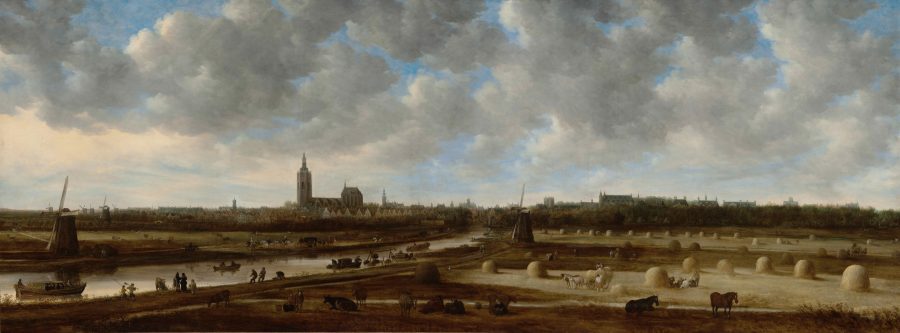
Van Goyen twice received a prestigious commission commanding a princely sum in payment. In 1651, the court paid him no less than three hundred guilders for a painting of “one of His Highness’s country houses situated in Burgundy.” Unfortunately, no information survives about this painting; it was probably destined for Honselaarsdijk Palace.80 In the same year, The Hague City Council commissioned a view of The Hague (fig. 6),81 for which they paid 650 guilders. At first sight, these prices seem outrageously high compared to what Van Goyen usually charged. They have always been referred to with astonishment.82 But the view of The Hague measures more than four and a half meters wide, and Van Goyen exchanged his usual method of working for a more refined and detailed style. The painting, one realizes, must have taken him more than ten times as long as he usually spent even on a substantial painting. Moreover, apart from its size and many fine details, such a specific commission would not have relied on existing sketches or his memory. He would have made new topographical drawings, adding to his investment of time.
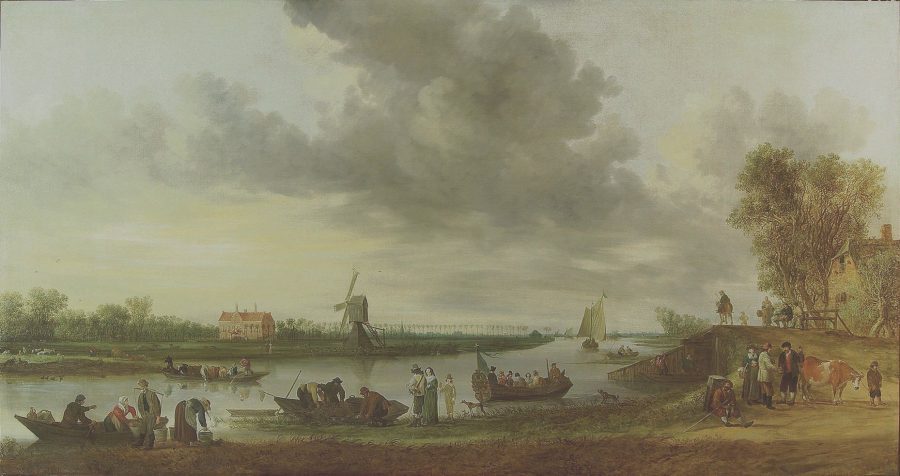
This painting clearly shows that Van Goyen made a stylistic choice. He chose the “neat” style for specific occasions, probably when the price had been set in advance. Similarly, the two-and-a-half-meter-wide view of the river Vliet near Leiden, featuring the country seat Roucoop {more recently identified instead as Oostbos}, was undoubtedly produced on commission (fig. 7).83 Given their format and careful finish, a number of other paintings must have been painted on commission as well—for example, the four exceptionally large views with town profiles, roughly one-and-a-half by two meters each, all painted in 1641. Two of them are views of Dordrecht and Haarlem, probably painted as pendants; their dimensions are exactly the same (161.5 x 254 cm), and their compositions perfectly match one another.84 Someone must have wanted prestigious paintings of the two oldest cities of Holland. Dordrecht and Haarlem had the oldest city rights, a position still considered of great importance. In the hierarchy of cities, they were officially numbers one and two. This was the order in which the representatives of the cities always spoke in the meetings of the States of Holland. The painting of the Valkhof in Nijmegen, only a few centimeters shorter in height, was possibly a commission from that city (fig. 8). The large canvas with the view of Rhenen is somewhat smaller but might have been cropped (143.5 x 221.5 cm).85 One might wonder whether these two, together with the paintings of Dordrecht and Haarlem, were originally meant as a series of four—but their compositions make this hypothesis seem implausible.86
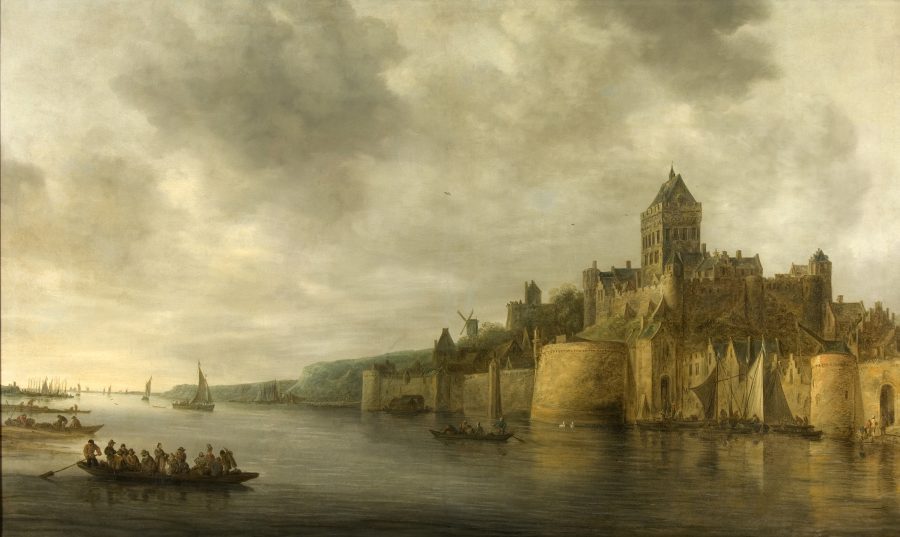
Van Goyen’s large production and long career explain, in part, why the prices of his paintings did not rise above a certain level during his lifetime, notwithstanding his great fame; numerous works by him were always available on the art market. When works of a famous painter are rare, this affects prices.87 In understanding the relatively high valuations of works by Jan Porcellis, the other highly acclaimed master in the “rapid manner,” we should not forget that their prices are known from inventories made after he died (1632), when his works had become scarce.88 As Van Mander notes in his biography of Joachim Beuckelaer, after the death of a master the value of his paintings could rise rapidly.89 This certainly happened after Porcellis’s death.
After Van Goyen’s death, by contrast, a similar increase in value did not take place. Apart from the huge number of his paintings on the market, quickly painted “monochrome” works went totally out of fashion. Paintings by Porcellis were fetching lower prices after 1660 as well. Later in the century, the valuations of their works became even lower, and the inventories mention them less frequently. This does not mean that their paintings disappeared without a trace but that their presence in the more prestigious collections dwindled, or they were not deemed important enough to mention. It may even mean that their names were not familiar anymore, and their works were therefore listed as anonymous. Some other masters of the same generation, such as Pieter de Molijn, Dirck Hals, Jan Miense Molenaer, or Pieter Codde, became frankly obscure. These painters, who were highly popular during the second quarter of the seventeenth century, were only mentioned in passing or not at all by the biographer Arnold Houbraken. In eighteenth-century auctions, their names all but disappeared.
Although Van Goyen’s fame never sank so low, his name does not appear in Houbraken’s list, drawn up in the early eighteenth century, of the sixty most renowned painters active between 1560 and 1660.90 He shared that fate with all painters who used the rapid and “monochrome” technique, with one exception: Jan Porcellis. Apart from Jan Porcellis, the canon had shrunk to painters who worked in a refined style with bright colors. As Gerard de Lairesse put it, “dirty and grayish-green colors” no longer pleased the eye.91 The only landscape painters of Van Goyen’s generation to survive on Houbraken’s list were Cornelis van Poelenburch and Bartholomeus Breenbergh.
Monochromy, Virtuosity, and “Realism”
For viewers today, Van Goyen’s “monochrome” coloring is probably the most striking aspect of his work. Indeed, many painters of his generation—including still-life painters and genre painters—used a restricted scope of mostly brownish, yellowish, and greenish colors, but Van Goyen applied this palette in the extreme through the 1630s and 1640s. The word “monochrome” is used for the sake of convenience; naturally Van Goyen’s paintings are never entirely monochrome, and every few years he changed his coloring slightly.92 As we have seen, this coloring facilitated a rapid, inexpensive production technique. Esaias van de Velde and Jan Porcellis were the ones who first experimented with a radically reduced range of colors, combining this with a fluent, brisk application of paint on a thin ground.93 By using only a few colors, they could accelerate their pace, restrict the number of palettes to one, and paint “wet-into-wet,” which saved labor costs.94 And with the production of a larger number of paintings, the material costs could also be reduced; ochers and other earth colors were in fact the cheapest.95
As we concluded above, this quick and cheap production did not diminish Van Goyen’s high appreciation by connoisseurs. Notably, Van Hoogstraten maintained that many painters chose this manner of working to obtain not only “profit” but also “fame.” Thus the economic motivation must have gone hand in hand with the artists’ ambitions to distinguish themselves artistically. These painters aimed for a high degree of virtuosity that gained them the connoisseurs’ admiration. It is not by chance that Van Hoogstraten’s description of Van Goyen’s painting technique during the “painter’s contest” with Porcellis and Knibbergen concentrates on the fabulous virtuosity with which Van Goyen—in a heartbeat—conjured up a whole range of motifs out of nothing. He relates how Van Goyen first loosely covered (overzwadderde) his whole panel, “here lighter, there darker, more or less like a multihued agate or marbled paper.” He then:
. . . began to seek out all kinds of amusing things, visualizing them with great facility through many small brushstrokes. Thus, in the distance, a pleasing view with farmhouses appeared, and nearby one saw emerging an old town wall with a water gate and jetty reflected in the rippling water, and ships and barges laden with cargo or travelers leaving and arriving. In short, his eye, as if trained to pick out all kinds of things that were hidden in a chaos of paint, steered his hand and mind swiftly, so that one was seeing a perfect painting before one well and truly realized what he intended to do96 (see, for example, fig. 9).
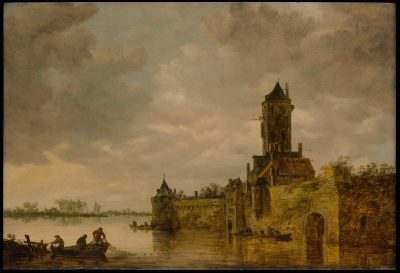
Van Hoogstraten’s emphasis on the apparent chaos out of which—as if by chance—many visible things quickly appear and then merge into a perfect painting reflects the amazement and admiration that viewers of the time had for a casual, virtuoso handeling (manner of painting).97 With this handling, Van Goyen responded to contemporary connoisseurs’ high appreciation for artists’ seeming nonchalance in achieving a convincing rendition of the real world. “How is it possible that the brush can suggest so much softness with such rough touches and such unattractive colors, and that by way of such casualness one can produce something so agreeable?”98 These words, from a French pamphlet of 1635, were suggested for people who, while visiting a workshop, wanted to say something intelligent. They apply well to works by Van Goyen.
Van Goyen seems to have used a rapid painting technique and monochrome colors to show off his breathtaking ability to suggest all visible things—substance, texture, space, and atmosphere. He accomplished this with the most limited means: little time, limited and cheap materials, and a range of only a few closely related color gradations. When his method was successful, and when it sparked the admiration of many liefhebbers, his art’s most eye-catching features became a fashion followed by many others.
It is curious that art historians in the twentieth century again and again emphasized that through this “monochrome” or “tonal” manner of painting, which reached its peak in the 1640s, Van Goyen was able to render realistically the singularity of the Dutch landscape and its humid atmosphere. Not only foreign but also Dutch art historians repeated this continually.99 The Dutch should have realized the artificiality of this coloring; in no way does it present a “realistic” image of the Dutch landscape. Apparently, their mental image of the Dutch landscape was influenced by their admiration for Van Goyen’s depictions. Perhaps this notion originated in the second half of the nineteenth and the first half of the twentieth centuries through the experience of black-and-white photographic landscapes, which aimed at an atmospheric rendition of the landscape through the careful refinement of monochromatic tones.
Few other painters have been able to suggest the atmosphere of the Dutch “waterland” as convincingly as Van Goyen, but he accomplished this rather in spite of his monochrome manner of painting. For Van Goyen’s and Molijn’s dunescapes from the late 1620s and early 1630s, the limited palette, with its many gradations of yellows and browns, is appropriate. But brownish or grayish-green tones are not at all characteristic of Dutch pastures, lakes, and rivers, which Van Goyen depicted in large numbers from the 1630s until his death in 1656. On the contrary, bright colors characterize the Dutch waterland, which was depicted as such by painters of the younger generation: Paulus Potter, Willem van de Velde the Younger, and the latter’s brother Adriaen.100
The colors of Dutch pastures and waterscapes become muted only when fog develops. But when that happens, visibility is seriously limited and the details of the far distance vanish, whereas in Van Goyen’s depictions, many details are present on the horizon. Moreover, under actual foggy conditions, a graying of the colors takes place, while nearby the manifold hues of the landscape still remain.Many authors see a misty atmosphere in Van Goyen’s paintings, but there is never any discernable fogginess in his works. The sentence with which Van de Waal finishes his book—“His art knows no doubt other than that of the mist above the water and no delight other than the triumphing light”—is splendid, but only the second part of the sentence characterizes Van Goyen’s work (Van de Waal, Jan van Goyen, 60).101 In his paintings, however, Van Goyen always suggests that the clouds are parting; when that happens, the Dutch waterland presents a wealth of strong colors. Therefore, brown meadows, light brown water, hazel-colored surfaces of ice, and yellowish-brown towns and town walls along a river or in the distance are all totally artificial. As demonstrated above, Van Goyen introduced this palette in conjunction with his new manner of production. Simultaneously, the muted palette became an aesthetic ideal. Long before the arrival of black-and-white landscape photography two and a half centuries later, Van Goyen knew how to achieve a convincing atmospheric effect through the incredible refinement in gradations of one color, creating the impression of immeasurable distance.
Moreover, the effect of a distance in which all shapes, through their light colors and indistinct contours, often seem to dissolve at the horizon into the cloudy sky is not because Van Goyen painted a very humid atmosphere but because he painted the landscape almost contre-jour. From the beginning of the 1630s on, Van Goyen frequently depicted his scenes as if the viewer is facing the light—while the sun hides behind the clouds—which usually comes obliquely from left of center (fig. 10). In such circumstances, the humidity in the air causes a stronger effect of blurring than when the light comes entirely from the side, or when one looks in the same direction as the light. Cornelis van Poelenburch was probably the first to introduce the effects of backlighting in his Italianate landscapes (fig. 11).102 In the second half of the 1620s, Porcellis was the first to achieve this effect in his water landscapes, and thereafter Van Goyen implemented this idea in his own landscapes. Van Goyen’s contre-jour effect was not the low, yellowish backlight skimming the ground that such Italianate painters as Jan Both and Nicolaes Berchem adopted (suggesting the light of morning or evening), but a clear backlight from a cloudy (but not fully covered) sky in the middle of the day.
Van Goyen depicted immense distance breathtakingly. On a miraculously small strip of painted surface (usually only a few centimeters high), he was able to suggest a view across flat (water)land many kilometers deep. If he had rendered this narrow strip of landscape with an abundance of colors more based on reality—with many strong colors in the foreground that change into paler grayish hues in the background—he would never have been able to achieve this atmosphere of intense, vast calm. This calm characterizes most of his landscapes despite the manifold activities they contain. As Van de Waal astutely remarked, his atmosphere can best be described by the untranslatable Dutch word stemmigheid (something like “subduedness”).103 By stimulating the eye with the fewest possible colors—especially in his paintings from the mid-1630s on—Van Goyen subordinated all elements in order to achieve this quiet and calm. His seemingly simple, but very sophisticated, compositions contribute to this result.
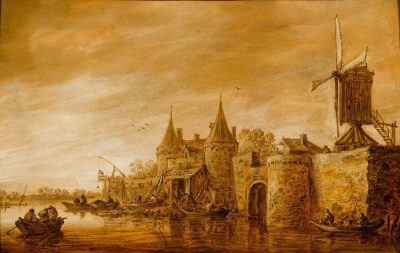
In a few cases, contemporaries compiling inventories considered the monochrome quality of a Van Goyen painting so prominent that they called it een grauwtje (a grisaille), the same term used for the truly monochrome works of Adriaen van der Venne. In Jan van de Cappelle’s collection inventory, for example, these “grisailles” from Van Goyen’s oeuvre were recognized as a separate category: two of the ten works by the master are described as such.104 The same qualification, incidentally, was also given to several paintings by Porcellis and Esaias van de Velde (and to an Ecce Homo by Rembrandt). In the case of the Van Goyens, it probably describes a number of small, late works in which indeed almost all color has been expelled and the whole has been painted in variations of gray-brown. This is most conspicuous in a group of works painted in oil on paper, all of them dated between 1650 and 1651 (fig. 12).105 With other works—especially the larger and more elaborate pieces—we must allow for the possibility that the blue in the sky might originally have been stronger. Houbraken stated that Van Goyen’s paintings “usually . . . are somewhat monochrome or gray: but that is not how they were painted at the beginning; in that time there was a color they called Haarlem’s blue, not used anymore because it is not stable, that was the cause thereof.” This remark has often been dismissed; Houbraken may not have understood the effect Van Goyen aspired to.106 Since Houbraken was surely well informed of the painting practices of the generation before him, David Bomford assumed that this Haarlem’s blue may have been a cheap quality of smalt that can indeed discolor to yellow-gray in an oil medium.107 {Melanie Gifford, however, doubts that Van Goyen used a smalt that later discolored; in her view, the considerable variation in his late work—where some paintings feature a smalt that is rather brightly colored and others include a smalt that is almost colorless—indicates that these differences were a matter of choice.108}
Youthful Ambition
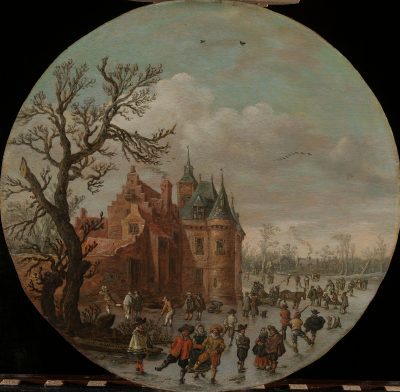
Van Goyen developed his most characteristic style (the rapid manner of painting, the elimination of local color) only after he had been working as an independent master for almost ten years; by that time, he had acquired a reputation for paintings with colorful, detailed figural staffage (fig. 13). He began his career as an independent artist after an exceptionally long and relatively expensive apprenticeship.109 This long training is probably indicative of the ambitions of his father, a shoemaker whom Orlers called “a lover of draftsmanship and the art of painting.” The young Van Goyen started his training at an early age, when he was only ten years old;110 thereafter he served about eight years as an apprentice to no fewer than five different masters. After he traveled to France and had been working on his own for some time, his father acknowledged that “he was well advanced in the art of painting and that his son aspired to be able to move further.” Only then, around his twentieth year, did he apprentice with “the excellent, renowned landscape painter Esaias van de Velde, with whom he stayed for a whole year.”111 Both father and son Van Goyen took great pains for Jan to experience as thorough an education as possible. Finishing his training with Esaias van de Velde was a well-informed choice, as Van de Velde’s specialty and particular skills were those that the young Van Goyen wanted to acquire. This choice lastingly determined the character of Van Goyen’s work.
When we compare Van Goyen’s paintings from his early period (1620–1626) with the landscapes Esias van de Velde made while the young painter was his apprentice, we see that, on the one hand, Van Goyen made considerable use of the local landscape motifs that Van de Velde depicted in paintings, drawings, and prints (figs. 3a, 14). On the other hand, the young painter wanted to distinguish himself by combining these motifs with a more precise and colorful manner of painting and more richness of vivid details (figs. 13, 15). In this regard, he followed in the footsteps of many older masters, from Hans Bol to Jan Brueghel the Elder (fig. 16), David Vinckboons, and Hendrick Avercamp (fig. 17). In addition, he became—and his contemporaries were quite aware of this—a very competent painter of figures. Other landscape painters even asked him to paint their figures.112
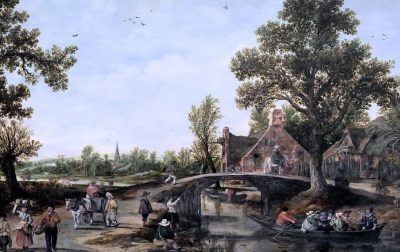
More faithfully than his master, Van Goyen followed Karel van Mander’s advice to be sure to strive for “much diversity of colors as well as of nature . . . / Because that brings great and laudable beauty.”113 Van Goyen combined Esaias van de Velde’s highly innovative landscape type, in which the local Dutch countryside is rendered with a swift brush, with this call for “varietas” (Van Mander’s verscheydenheyt, diversity).114
Perhaps the young Van Goyen found a justification for his style in a famous example from antiquity, striving to match the antique painter Ludius, whom Van Mander, in his account of “diversity in landscapes,” mentions as the greatest example of an artist who enriched his paintings with a large variety of motifs.115 Moreover, Van Mander’s account reads as though he perceives Ludius’s work as the portrayal of a directly experienced environment. When Van Mander records that Ludius’s admirers considered a painting of a low swamp with farmhouses and slippery, muddy roads to be his best work, it is almost as if Ludius were a Dutch landscape specialist.116 This might even have encouraged artists to avoid uitheemse pronk (embellishing motifs that are foreign), in the words of the poet Spiegel.117
Some parts of Van Mander’s account of Ludius’s landscapes, which are repeated (in prose) in his biographies of antique painters (all derived from Pliny), read almost like a description of early work by Van Goyen (see fig. 15). In his landscapes, Ludius painted people who “strolled outdoors for recreation, or spent their time boating for pleasure.” He also depicted donkeys and loaded wagons next to farmhouses, and various other rural activities like men fishing, catching birds, or hunting.118 Van Mander’s observation that Ludius demonstrates how a Const-lustighen gheest (somebody with an artful mind) can achieve wonderful results would have been an inducement for a young and ambitious painter to imitate the ancient artist. We cannot know whether the young Van Goyen deliberately emulated this example from antiquity and thus, in his own way, “revived” Ludius’s style.119 However, it seems likely that the story of Ludius, “the first inventor who set himself to painting landscapes,” and whose example generally supported the self-respect of all painters specializing in landscapes in this period, was common knowledge in the workshop of such a famous landscape painter as Esaias van de Velde.120
Although Van Goyen’s early paintings undeniably represent a personal, identifiable type of landscape that would have been recognized as such by his contemporaries, none of his motifs are in and of themselves absolutely new. It is not only to the work of Esaias van de Velde (and of the older generation of landscape painters mentioned above) that we can trace Van Goyen’s landscape motifs, human figure types, and activities. The repertoire as realized in the many print series by Claes Jansz. Visscher and Jan van de Velde II (figs. 18 and 19), which had become popular in the previous decade, appears to have been crucial for Van Goyen. By selecting his motifs with care, he allowed the viewer the opportunity to peruse numerous vivid (stereo)types—farmers, fishermen, hunters, city people, soldiers, horses, dogs, cattle—going about their business in a peaceful country village on the border of the dunes and waterland. In the imagination of the well-to-do town dweller, these were “pleasant” places.121
As a young painter who had to establish a name for himself, Van Goyen chose a path without too many risks; he adhered to motifs that were already well known and types of paintings that Esaias van de Velde had successfully introduced. This is not only true for his summer landscapes with village views, but also for the “winters” (figs. 13a, 20).122 In these, he combined many elements of the styles of two popular masters, Esaias van de Velde and Hendrick Avercamp. The compositional motifs (a castle in the middle ground, a bare tree as a repoussoir) as well as the large number of cheerful staffage details often recall the Flemish tradition to which Avercamp’s work directly connects.
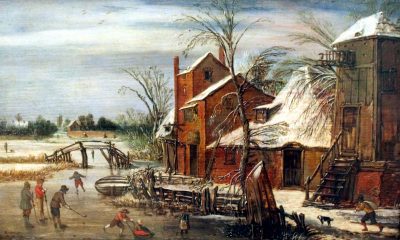
As in his other early paintings, Van Goyen combined these features with motifs he had learned from Esaias van de Velde (fig. 21), such as a lower viewpoint and a tighter organization of the figure groups along compositional lines leading into the distance. The atmosphere of wintery bareness and chilliness that Esaias van de Velde often strove for in his sober winter landscapes did not appeal to Van Goyen. He was especially concerned with a great “variety” and a proud display of his capabilities as a figure painter, elements with which he, as a Dutch Ludius, aimed to draw the attention of the liefhebber. Judging by Huygens’s remarks (written in the beginning of 1631), he succeeded.
A Change of Course
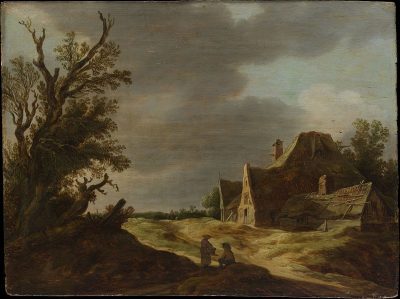
The transition to another type of painting took place rather abruptly. In 1627, Van Goyen had the courage to change this type almost overnight, possibly in the face of increasing competition (fig. 22).123 From then on, he no longer displayed his ability through a richness of motifs and details but through a seemingly casual ease in suggesting an environment based on drawings after nature—the inner dunes (at the time deforested), with some dry vegetation and a few farmhouses or a country inn here and there. All these motifs could be found in abundance in the countryside between Haarlem, Leiden, and The Hague and were familiar to inhabitants of those towns.
Pieter de Molijn and Pieter van Santvoort—building on motifs that Esaias van de Velde had introduced in prints and paintings around 1614 (figs. 3b, 23)—were probably the first to transform Esaias’s van de Velde’s innovations into this new type of dunescape (fig. 24).124 They did so slightly earlier than Van Goyen, and Van Goyen must have recognized the possibilities immediately. He might have begun producing these unadorned dune landscapes initially in competition with Molijn, whom he surely knew from the period of his apprenticeship in Haarlem. Van Goyen’s experiments with this new type turned out to be very successful.
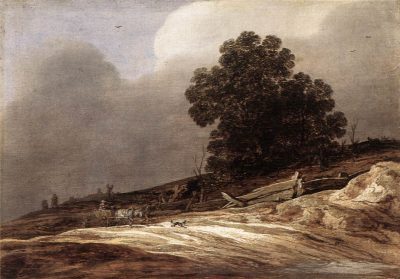
The young Salomon van Ruysdael immediately embraced this subject too, while Van Goyen’s Leiden contemporary Pieter de Neyn (another competitor)125 also followed in the same year, 1627. These painters, it seems, began to bid against each other in simplifying their compositions and color palettes as much as possible. The limited range of yellow, brown, and pale green tones was very appropriate for this type of landscape. Even more than the others, Van Goyen went to the extreme, displaying virtuoso mastery with a minimum of means for maximum effect (fig. 25).126 Thus, for Van Goyen and some of his most talented colleagues, economic and artistic endeavors merged perfectly.
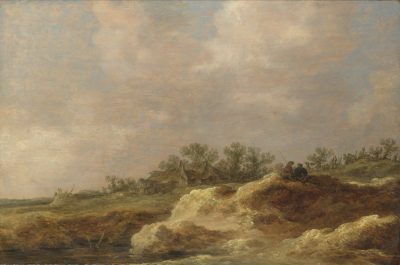
The farmhouses in particular, with their irregular and sometimes even fantastic shapes, still guaranteed a certain “varietas,” despite their coloristically austere environment. They are poor and shabby, but by seventeenth-century standards probably not alarmingly dilapidated (fig. 26, 27).127 In combination with the chatting or quietly strolling country people, these motifs may have presented to the urban audience a comforting image of simple rural life, where one is free of desire and pride and content with the basic essentials of natural existence.128 Given Van Goyen’s vast output, clients must have considered the dunes an attractive landscape type. In an age in which the representation of nature was viewed as praise for God’s creation,129 it is possible that for the people living in the cities of Holland the image of the dunes—as protectors of the land against sea—read as a manifestation of God’s grace. “God’s goodness is apparent from the top of every dune,” Constantijn Huygens wrote. Moreover, the citizens of Haarlem, Leiden, and The Hague saw the dunes as a major destination for relaxing walks or amusing outings. That, too, would have contributed to this landscape genre’s popularity.130
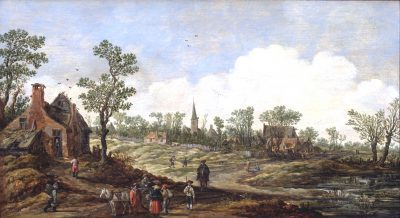
In these works, Van Goyen and other artists increased the viewer’s involvement with the depicted landscape through a radically changed viewpoint. In Van Goyen’s early landscapes—as with all landscape paintings by Esaias—we see the land and the figures somewhat from above, as if we, the viewers, are standing on a raised part of the land, a mound, or a small hill, or looking out from an upper-floor window (fig. 28). In that way, characteristic of sixteenth- and early seventeenth-century scenes, all figures are situated at different distances below the horizon. This makes possible the representation of a large number of figures over all the planes, from foreground to background.
In 1627, however, Van Goyen started to paint landscapes in which the viewer is positioned at a much lower vantage point (fig. 22)—an experiment that he continued systematically in 1628 and 1629 (figs. 2, 25, 26, 27). The eye of the viewer—indicated by the horizon—is now at the same, or almost the same, height as that of the figures within the image. The viewer is standing, as it were, at the same level and looks straight at the figures or even up at them when they are placed on an elevation in the landscape or on a wagon that raises them above the horizon.131 The suggestion that we are looking at a landscape rendered “from life” is therefore much more convincing.132 Sometimes our view is limited because we look against a rising dune, so that we cannot see the horizon hidden behind the dune. Then we see only the top of a farmhouse, the crown of a tree, a spire, or the heads of the figures emerging above, an effect that is typical when strolling in the dunes. The borderline between our world and the world in the painting is eliminated as much as possible; it seems as if one could just walk into the landscape.

In previous years, Van Goyen had rendered the low viewpoint many times in his drawings (fig. 29), but from this moment on he used this method in paintings as well to create a much more direct confrontation with the suggested surroundings. Along with the shift in viewpoint, he had to reduce the figural staffage considerably, at least in the foreground. When the eye level of the viewer and the figures in the painting are the same, the figures in the foreground (so frequently present in earlier works [figs. 13, 15, 20, 28]) need to disappear. They would otherwise cover a large part of the landscape and become too dominant, as we see sometimes in drawings of the period that are primarily figure studies (fig. 30). Van Goyen had to place the figures much deeper in the landscape. Apart from the elimination of the figures in the foreground, a radical reduction in number of figures within various planes was necessary as well; when the horizon is at the height of the represented figures’ eye level, they would mostly overlap each other. Moreover, a monotonous isocephaly (all heads at the same level) would occur. In order to prevent this, the smaller number of remaining figures are placed at different levels: under the horizon, by rendering them in a sitting position, and above the horizon, by placing them on a mound, a little hill, or a wagon.
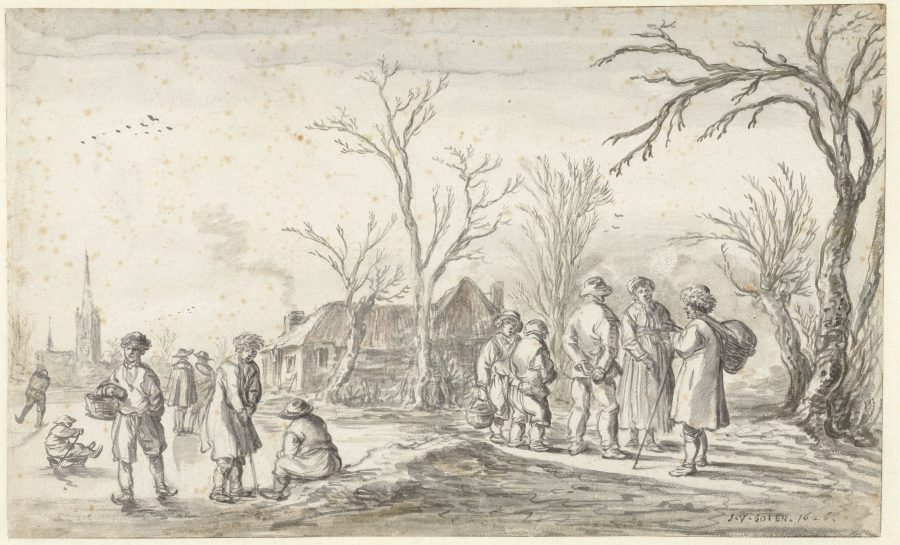
The feeling that one could just walk into the landscape, like a stroller on the road through the dunes, is amplified by strong “lines of perspective” created by the country roads, buildings, and vegetation that together emphasize receding movement into the far distance. Previously, the farmhouses, trees, and other motifs were placed behind each other as parallel screens (fig. 28), but now they are linked together by placing them, as it were, along oblique lines (which have often been called “diagonals” by art historians) that lead the eye into the distance, at the same time shaping those lines (fig. 27). Thus, a forceful thrust into space is achieved. Not only does it guide the eye into depth; it also creates a suggestion that the depicted space extends forward out of the painting to continue, as it were, into the viewer’s own space.
The low viewpoint, the strong spatial movement, and the reduction of the many motifs reinforce the “from life” (naer het leven) effect of the paintings. The illumination contributes to that effect as well. In the early landscapes, the contrast between the conventional dark strip in the foreground and the lighter middle plane is totally artificial. It provides a means to create a sense of space (fig. 28). As of 1627, the natural source is indicated: a strong shaft of sunlight slants from the left side, cutting across the middle plane; all elements are sharply lighted against the darker parts around them. The parting of the heavily clouded sky accounts for these seemingly sudden, bright sunbeams. All these changes allow viewers not so much to “read” the landscape with figures as to invite them to take part in it and enjoy it themselves.
A Continuing Source of New Types of Landscapes
Van Goyen’s production of dune landscapes found its apogee in the years 1631–1633. Afterward, the number dropped rapidly, and as of the mid-1630s, he only rarely painted such subjects. Although Molijn and many followers of Van Goyen continued this type of landscape much longer, Van Goyen apparently lost interest. The subgenre probably became less lucrative once his dune landscapes were available in large numbers. His followers apparently wanted a piece of the pie, flooding the market with numerous “dunes.” Van Goyen himself switched to new subjects. The river view became especially important for him, and later on views of open water with passenger boats and fishing vessels.
I will not discuss in detail Van Goyen’s immensely rich production of paintings from the 1630s until his death; that has been done several times.133 Here I will only indicate that again and again, after having produced a certain type of landscape in large quantities over the years, and seeing it adopted by others, Van Goyen developed a new theme and added it to his repertoire.134 He continued to innovate to keep clients’ interest in his works alive, and by doing that his art became a source of new types that were taken up immediately by many followers. Usually Van Goyen had already tried out, earlier, the subjects that he then later adopted for production on a larger scale.
As noted, besides (and after) the dune pictures, Van Goyen developed river views dominated by the river’s surface and a cloudy sky reflected in the water. He started this type in 1628. With their somewhat sandy shores and simple farmhouses, the paintings seem to render the landscape around the Oude Rijn (Old Rhine) between Leiden and Katwijk. Perfecting it during the 1630s (see fig. 10), he applied the “monochrome” coloring and rapid painting technique that he had originally developed for the dune landscapes. From 1634 on, he added a new variation in which the rivers are lined with castles, town walls, or other distinctive architecture. In the second half of the 1630s, his production of this type of landscape grew; throughout the 1640s, he painted them in large numbers (figs. 9a, 31).135
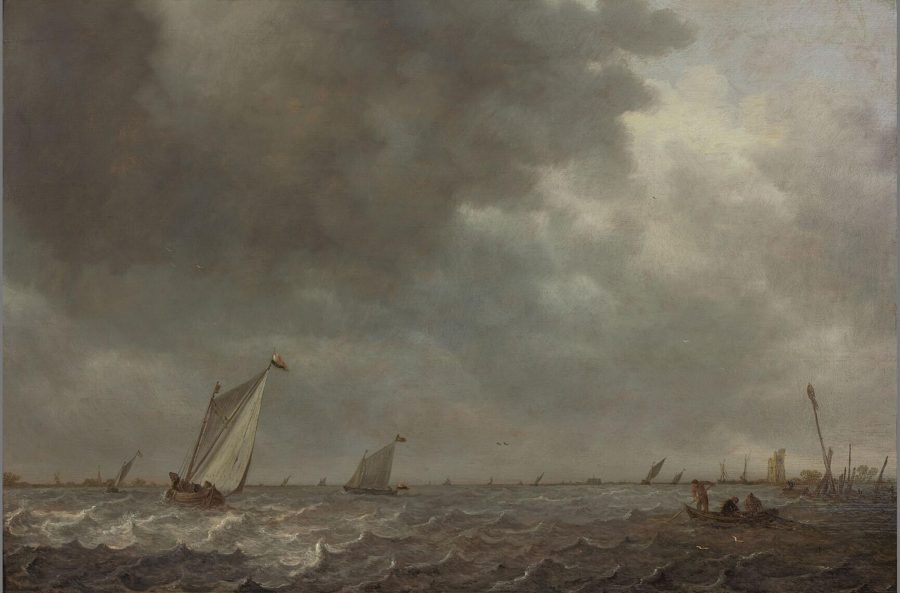
During the first half of the 1630s, when Van Goyen’s interest in the dunescape had passed its peak, the beach view first appears in his oeuvre; these works feature the church tower of Scheveningen (fig. 32) or Egmond many times, a subject he had already tried out occasionally.136 Especially in the 1640s, he painted numerous beach scenes (fig. 33), after which the number of paintings with this subject suddenly decreased considerably; in the 1650s, he produced them only incidentally. Van Goyen’s views of open water began, so far as we can trace, in 1636. This 137was once the specialty of Jan Porcellis, his senior by about fifteen years, whom he had known personally. Only after Porcellis’s death some years earlier, in 1632, did Van Goyen try his hand at such a subject. He must have seen a gap in the market, the more so since works by Porcellis had begun to yield high prices. Van Goyen’s early pieces in this subgenre are unmistakably related to those of the older master (fig. 34).
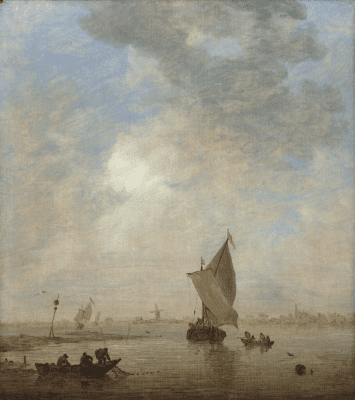
Although Porcellis’s work stimulated him at first, Van Goyen developed a personal type of open-water scenes in the late 1630s (fig. 35): wide, quiet views, mostly of lakes or estuaries with towns or villages in the far distance. Here, with breathtaking mastery and extremely limited means, he suggested an unbelievable vastness and compelling tranquility. He achieved this effect by subtle transitions of tone in the water and clouds, and by the unerring placement of vessels in the suggested space. At the same time, he drew the ships and many human figures on them with flawless perfection. During the last years of his long career, he must have found great success with just these works, because his late production largely consists of views of such calm waters. His clients, and he himself, would have been aware that he produced paintings of unequaled quality in this genre (fig. 36).138
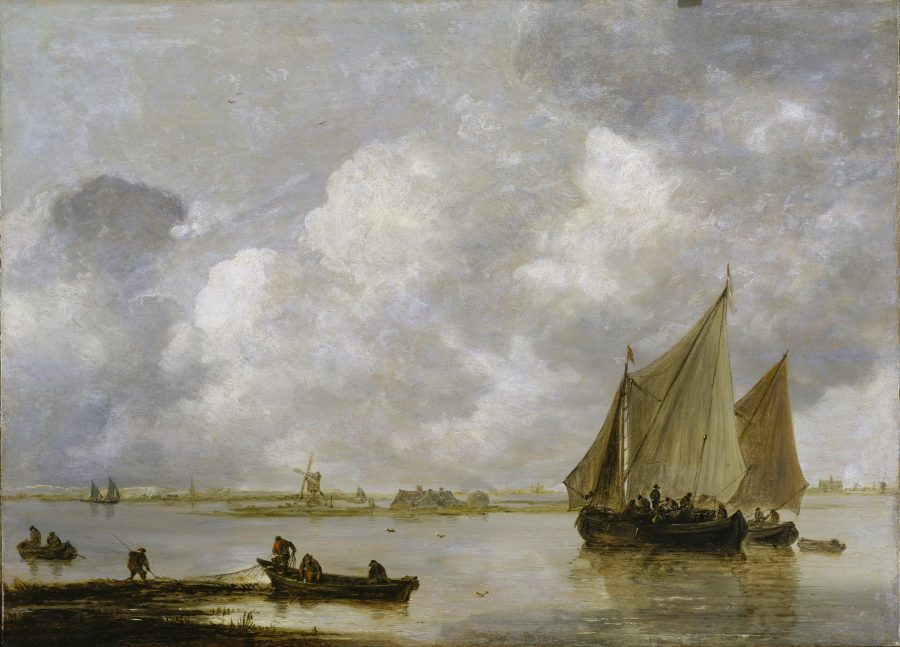
Van Goyen’s panoramic views flourished for a shorter time. He started this genre—probably inspired by Hercules Segers’s works—with views of Arnhem and Rhenen seen from the land side (in 1633 and 1636, respectively; fig. 37). Thereafter he depicted The Hague in the same way. From 1639 until 1647, he frequently made panoramic views in which not the town in the distance but the vast view itself plays the main role (fig. 38). After 1647, as far as we know, he abruptly stopped painting these large panoramic scenes.
The many views of such towns as Dordrecht, Nijmegen, Rhenen, and Arnhem, seen from the water, began to appear in Van Goyen’s work in the 1630s, at first rather hesitantly with views of Dordrecht and Nijmegen in 1633. The earliest views of Arnhem and Rhenen from the side of the river date from 1639 and 1641. In these paintings, Van Goyen combined the older tradition of the painted town profile—by such artists as Hendrick Vroom—with the river view or wide water view he had developed himself. By the end of the 1630s, these works became a great success; from that time until his death—reaching a pinnacle between 1641 and 1651—he would produce many views of towns along a river, especially Nijmegen (see fig. 8), Rhenen (fig. 39), Leiden (fig. 40), and Dordrecht (fig. 41), some of them very large in size.139 It is notable that in some years Van Goyen painted one town many times: 1644 and 1647 are peak years for Dordrecht (we still know five and six from these years, respectively) and 1646 for Nijmegen (six). Through the rich staffage of ferries, fishing boats, and sailing boats with passengers, and by changes of viewpoint and shifting of architectural elements, he continually provided remarkable variation.140

The ice landscape, finally, is the only genre that Van Goyen painted throughout his life. It had its first peak from the beginning of his career until 1627 (figs. 13b, 20a). After that, he painted the subject only incidentally; but it flourished again in the first half of the 1640s (fig. 42). Thereafter the number diminished, although he still made an ice landscape occasionally until the end of his life.141
As noted above, during the late 1620s and 1630s, Van Goyen worked with powerful “perspective lines” that pull the eye into the distance, at the same time experimenting more and more with the effects of backlighting. In that period, the viewer’s eye level is mostly about the same as that of the standing figures in the image. The foreground, for the most part, remains empty, and the figures are usually placed rather far into the distance. In the river landscapes, for example, the viewpoint is very low, as if the viewer were seated in a rowboat, or sometimes a bit higher, as if they were standing on the deck of a boat gliding over the water along the bank of a river, thus able to look infinitely far over the calm water toward the horizon.
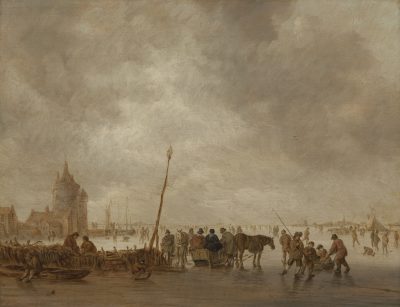
In the 1640s, Van Goyen began to experiment with different, much more complex compositional devices. The dominance of the “perspective lines” (“diagonals”) leading the eye into the suggested space diminishes considerably, and often they are intersected by elements that are parallel to the picture plane. The eye level of the viewer becomes more varied. Van Goyen often chose again a higher viewpoint, as if the viewer were standing on a high shore (in river landscapes) or on a low dune (in beach views). This higher viewpoint makes it possible to introduce more staffage in the foreground: a little boat with fishermen, a promontory with cows in the river in water landscapes, or in beach views, for instance, a little dune with some figures. On the other planes of the picture, too, space is dedicated to more figures; especially in the ice landscapes and beaches, Van Goyen could enjoy himself fully by depicting all kinds of human activities.
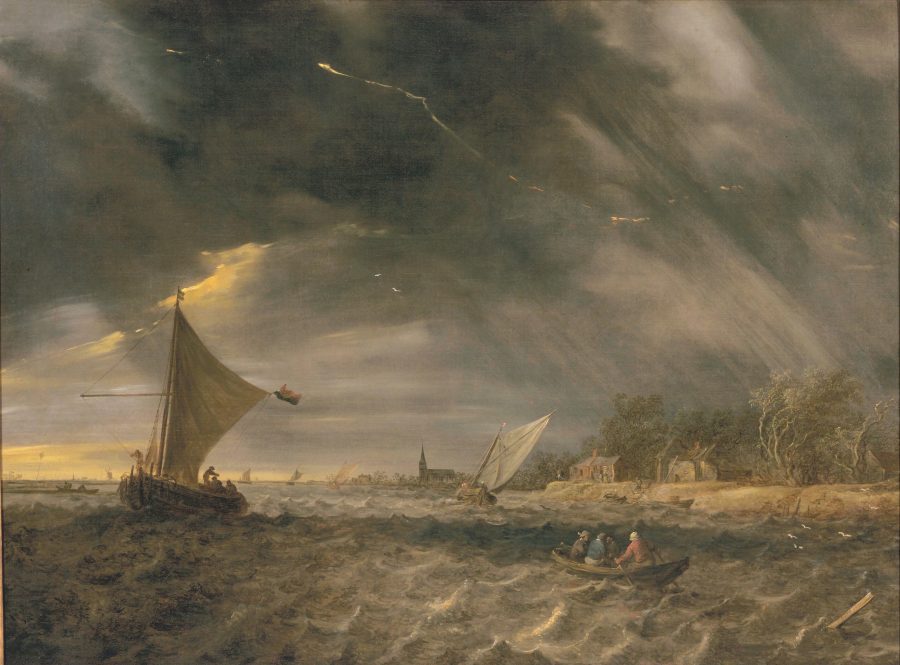
Not a breath of wind stirs in most of Van Goyen’s landscapes. In the river- and waterscapes the smooth surface of the water reflects clouds, the shores, and the boats. Sometimes the clouds seem to threaten, suggesting that the weather is going to change. On rare occasions, there is a strong wind. Only in a small number of paintings, all dated in the early 1640s, does Van Goyen explicitly depict bad weather with rain, a storm, or lightning (fig. 43).{142}
The languorous peace characteristic of so many of Van Goyen’s works reached a high point in his wide expanses of water of the 1650s (figs. 36a, 41a): summer days when the wind has dropped, and the fishing boats, yachts, and sailing barges full of passengers seem to sway gently on the calm water. A fine poem by the clergyman Jodocus van Lodesteyn (written between 1650 and 1653) evokes a similar atmosphere, leading the poet to religious reflections, but only after he first gives a beautiful description of an experience so familiar to every traveler in that time:
Did one ever see calmer weather?
The flags are drooping,
The sail is sagging,
And the only headway is made through the slow-moving tide.143
This essay placed the emphasis on Jan van Goyen as a “homo economicus.” Producing works in an economically efficient way, the painter was able to maintain a position as a market leader throughout his whole career. In an art market where the competition must have been fierce, he achieved this by developing and applying a style that was always recognizably “Van Goyen”, while time and again introducing into his repertoire new types of landscapes, which he continuously expanded and renewed. Subsequently, many others imitated his landscape types, which then became specialties of painters of a second tier.144
Van Goyen must have depicted this landscape with unflagging enthusiasm and intense love; his countless drawings testify to this as well. The first quality Samuel van Hoogstraten demanded of a good painter is that he “is in love with depicting the pleasantness of beautiful nature.”145 Jan van Goyen seems to have more than met this requirement. We can only agree with Willem Martin, who wrote in his unsurpassed 1930s survey of Dutch art: “But above all, Van Goyen is the gifted painter of the clouded Dutch sky and of everything that is dear to us in its watercourses and rivers.”146 I would add that the image of what is still precious to us in the Dutch landscape has been a good deal shaped by Van Goyen’s paintings. It is a miracle that such seemingly simple compositions were able to exert such a far-reaching effect. Many centuries later they still define our image of how breathtakingly beautiful the Dutch landscape can be—we still look for it when walking in the dunes or sailing over the lakes and rivers, even as we try to ignore the many signs of modern life.
Postscript
This article was written in 1995/6 as an essay for the catalogue accompanying the exhibition Jan van Goyen in Museum de Lakenhal, Leiden (October 1996–January 1997). The catalogue presented new approaches to Van Goyen’s work by Edwin Buijsen, Reindert Falkenburg, Melanie Gifford, and me.147 During the fall semester of 1995, I had held a seminar on Jan van Goyen at Leiden University, which greatly contributed to my thinking about his career and work. I made grateful use of students’ papers in the last part of the article.148
The present version of the article, which was translated for JHNA by Nicolette Sluijter-Seijffert and edited by Alison M. Kettering, is based on the original manuscript. It is more complete than the Dutch article published in the catalogue—at the last minute, before the catalogue was printed, sentences, parts of sentences, indeed whole paragraphs were cut because of the need to reduce the number of pages.
The essay’s goal was to examine Jan van Goyen’s painted oeuvre—with regard to its production, style, development, themes, and compositions—from different perspectives than had been usual up until then. New research on the art market by John Michael Montias and Neil de Marchi and Hans van Miegroet; on probate inventories by Willemijn Fock and Pieter Biesboer; and on technical art history by David Bomford and E. Melanie Gifford stimulated me to think about the “strategies” that ambitious artists might have used, consciously or unconsciously, to position themselves within the art market, making choices with respect to style, subject matter, and technique to target an audience in order to secure a place among a range of colleagues working in the same field. These artistic and economic concerns were often inextricably linked. Now, in rereading the article, I find all of this self-evident, but at that time it was thrilling and new. Jan van Goyen appeared to be the artist par excellence on whom to try out such research, even though I had never before immersed myself in landscape painting.
The second part of the article is devoted to a discussion of Jan van Goyen’s radical change in style and continuous innovations in types of landscape that were, in my view, directly related to his aspirations as a market leader in his field. This might sometimes read as a lecture for first-year students on visual analysis. But before the 1996 exhibition, descriptions of Van Goyen’s stylistic development were still given in purely formal terms, as if he were making abstract paintings, using “diagonals” (“a diagonal pattern,” “a diagonal-triangular scheme”) and reduced color only to “unify” the structure of his compositions. In that approach, characteristic of the first three-quarters of the twentieth century, there are no viewers whom the artist aims to involve in what is represented, let alone viewers who endeavor to imagine the scene before their eyes as a “real” space; a “virtual reality,” we might say now.149
More seventeenth-century inventories have been published (online) than those that were available at the original time of writing, although their numbers are still fewer than one would wish. The Getty Provenance Index now provides all the Haarlem inventories transcribed by Pieter Biesboer; the Montias Database contains all the inventories on which Montias based his article on works of art in Amsterdam. Piet Bakker provided me with more information about the Leiden inventories assembled by Willemijn Fock, among them the correct archival references. Because only a few more Van Goyen paintings with valuations have turned up than the ones I knew at that time, the average estimates I calculated when writing the 1996 essay remain more or less the same; apart from correcting a mistake in a footnote, only in one instance did I add {between curly brackets} information on estimates I did not have at the time.
In general, it is remarkable that, as far as I know, little has been published on Van Goyen and painters around him since the 1996 exhibition and catalogue, apart from a stimulating 1998 article by Reindert Falkenburg that both builds on Montias’s and my theses and takes issue with some of them.150 Art-historical interest in the depiction of the Dutch landscape seems to have waned over the last few decades. Yet the enormous surge in the production and collecting of landscapes representing the local environment—which, though not expensive, appealed more to sophisticated audience than to buyers of modest means—remains a fascinating phenomenon that deserves new research to deepen our understanding of seventeenth-century Dutch painting.
